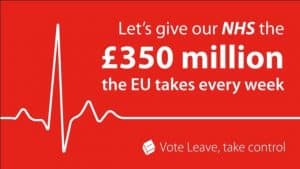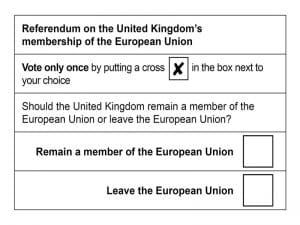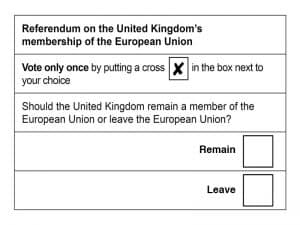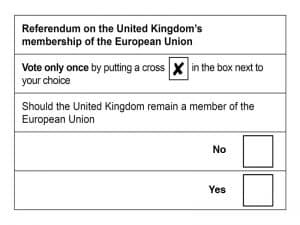Time to nail my colours to the mast: I’m one of the 48% and I am shocked and disappointed by the referendum result. But the people have spoken and we all need to move forward and make the best of the situation. As always, for businesses there are both threats and opportunities – navigating these will require a strong marketing strategy as well as steady nerves.
I am going try to step back from the politics of the result and instead look at what Brexit can tell us about marketing:
The always excellent Mark Ritson called the result over a week before the election, claiming (rightly) that Remain had lost the emotional battle. But I’d like to break this down into practical, everyday lessons that you can apply to your marketing strategy.
1) Understanding your audience
It is quite clear from the dismay and confusion of leading Remain campaigners that they failed the first rule of marketing, which is to know and understand your potential customers – what motivates them, what their needs are, what the potential barriers to purchase are. Leave, by contrast (and possibly more by accident than design), understood the target demographic very well and was able to condense the argument in a targeted and precise way.
Looking back, there was plenty of evidence available to the Remain camp, had they chosen to look for it. Lordashcroftpolls.com have published a forensic breakdown of voting intention by all sorts of demographic factors. Presumably similar polling data would have been available to the two campaign camps. Some understanding of the correlation between concerns and intention and some simple maths should have allowed the Remain team to focus a message that reflected people’s real (rather than imagined) concerns.
Lesson: understand your customers. Speak to them and when you can’t speak to them, use data to gain as much insight as you can.
2) The appeal of emotion
I’m not going to rehash Mark Ritson’s piece earlier, but suffice it to say that people buy with the heart and regret with the head. For many Leave voters, this wasn’t a rational cost-benefit analysis. This was a chance to vent frustration, to protest, to “take back control” that they felt they had been denied for a long time by the status quo. For the first time (at least in England) voters had been given a voice and a chance to define their own identity and they took it.
For some, buyer’s remorse may now be taking hold. The huge marketing challenge now for Boris or whoever takes over, is to stop that buyer’s remorse. In politics, voters need to be repeat customers. It’s five times harder to recruit a new customer than to retain an existing one – but this doesn’t apply if the customer feels they have been duped and that promises have been broken.
Lesson: customers always buy on emotion (even in a business to business setting). The rational cost-benefit analysis comes at different stages in the customer journey – either early on when they are still in the ‘research phase’ or later, after the purchase decision has been made. If it is the latter, you need to make sure that you have delivered an excellent product, service and experience and that no promises were broken.
3) Clear messaging
Arguably this is where Remain struggled most. Leave managed to condense its offering to two simple slogans: “Take back control” and “We send £350m to the EU every week”. Remain never had anything similar, as all the arguments for staying were complex and nuanced and did not lend themselves to simple, catchy slogans with instant recall.

Vote leave advert
Lesson: work hard to condense your offer. The more simple, the easier to understand, the more memorable (and shareable) it becomes. If you have complex products or services, think how you can segment your audience and target specific messages to specific groups.
4) Choose the right channels
How and where you communicate is critically important. Leave had the press, the big red bus, a simple message ideally suited to social media and a massive group of grassroots “brand advocates” ready to spread the message. Remain, by contrast focused its marketing on its comfort zone of cosmopolitan cities. Backed by broadsheets, but not tabloids, it hardly ventured to the northern and eastern English leave heartlands, leaving the leavers free reign to set the agenda.
Lessons: choose the same marketing channels as your target audience and speak to them in their voice. And never neglect brand advocates: harness your existing customers to spread the word and recommend your product. Word of mouth is by far the most powerful marketing tool there is.
5) Brand recognition
This is probably another “by accident, rather than design” thing, but Leave had the brand: #brexit. Instantly recognisable and memorable, it also set the agenda (exit!), rolled off the tongue nicely and sounded friendly and breakfast-cerealy. Not scary at all. Remain had no equivalent.
Lesson: brand is important. It influences how your customers see you and acts on an emotional level. A good brand can build trust, recognition, identity and desire. If you get it right, it makes your other marketing so much easier.
6) Language matters and so does design!
I have a sneaking suspicion that the referendum was lost the moment the referendum wording was set*. This is the official polling card:

Official polling card
But consider this alternative:

Alternative polling card
Or what about this?

Alternative polling card
There are two basic problems for Remain with the official card, one of design and one of language. First, consider the layout of the official card: all of the layout and weight of the copy naturally draw the eye down to the bottom right corner. It draws you down to leave.
This is an important element of all good marketing design – use visual cues to lead the customer towards the action you want them to take.
Now lets look at the wording: firstly, there is a reason the electoral commission rejected a Yes / No answer. It is much easier to answer yes than no. Nobody likes to be negative or to reject things. Secondly, the Remain option is long and complicated. Leave is much shorter and easier to read. By the time you have processed the Remain information, your brain has already subconsciously digested “Leave”. Finally, Leave is last. There is a reason why sales letters or emails often end with a PS. It is because people naturally skim to the end. They will look at the headline, maybe the opening sentence and then the end before deciding whether all the other copy is worth reading. This is why you should always finish your marketing communications with a strong call to action.
Lessons: use design and layout to lead customers where you want them to go. Emphasise positive, clear messages. Always end with a strong call to action.
7) Final lesson
We may be in for a bumpy ride for business and the economy. Nobody knows what will happen, but if there is a downturn, the companies that prosper will be those that invest in their marketing. If you turn off the tap, the flow of customers into your business will stop. It’s very important that you maintain a healthy pipeline by planning and investing in good quality marketing throughout. Marketing should never be seen as a cost – it is an investment in your company’s future.
So there you have it, a hopefully politically-neutral Brexit marketing guide. Please tell me what you think and don’t forget to get in touch for more marketing advice and help.
How Msgworks can help:
- Customer and competitor insight and analysis
- Bespoke marketing plans and budgets
- Training (marketing strategy, social media, SEO, email)
- Fully managed campaigns
- SEO
- Email marketing
- Websites and website reviews
- Design and copy
(main image photo credit: Jeff Djevdet, speedpropertybuyers.co.uk)


Nailed it. While we like to think that more thought goes into the future of the country than which brand of peanut butter to buy, the decision making process (at least subconsciously) is of course much closer. There was a lot of ‘chatter’ around the ‘leave’ camp – this, for me, sealed it.